David Game College: Contemporary Sociological Issues Report
VerifiedAdded on 2023/01/05
|12
|3931
|100
Report
AI Summary
This report provides a detailed analysis of contemporary sociological issues, beginning with an introduction to the concept of contemporary issues and their impact on society, particularly in light of the COVID-19 pandemic. The main body of the report explores the debate of structure vs. agency, followed by a critical analysis of structural theory, and a theoretical review of socialization. It further examines group formation, societal constructs, and social change, including the effects of COVID-19 and globalization on public services. The report discusses societal constructs and concludes by summarizing the key findings and implications of the sociological issues discussed. References are provided at the end of the report.
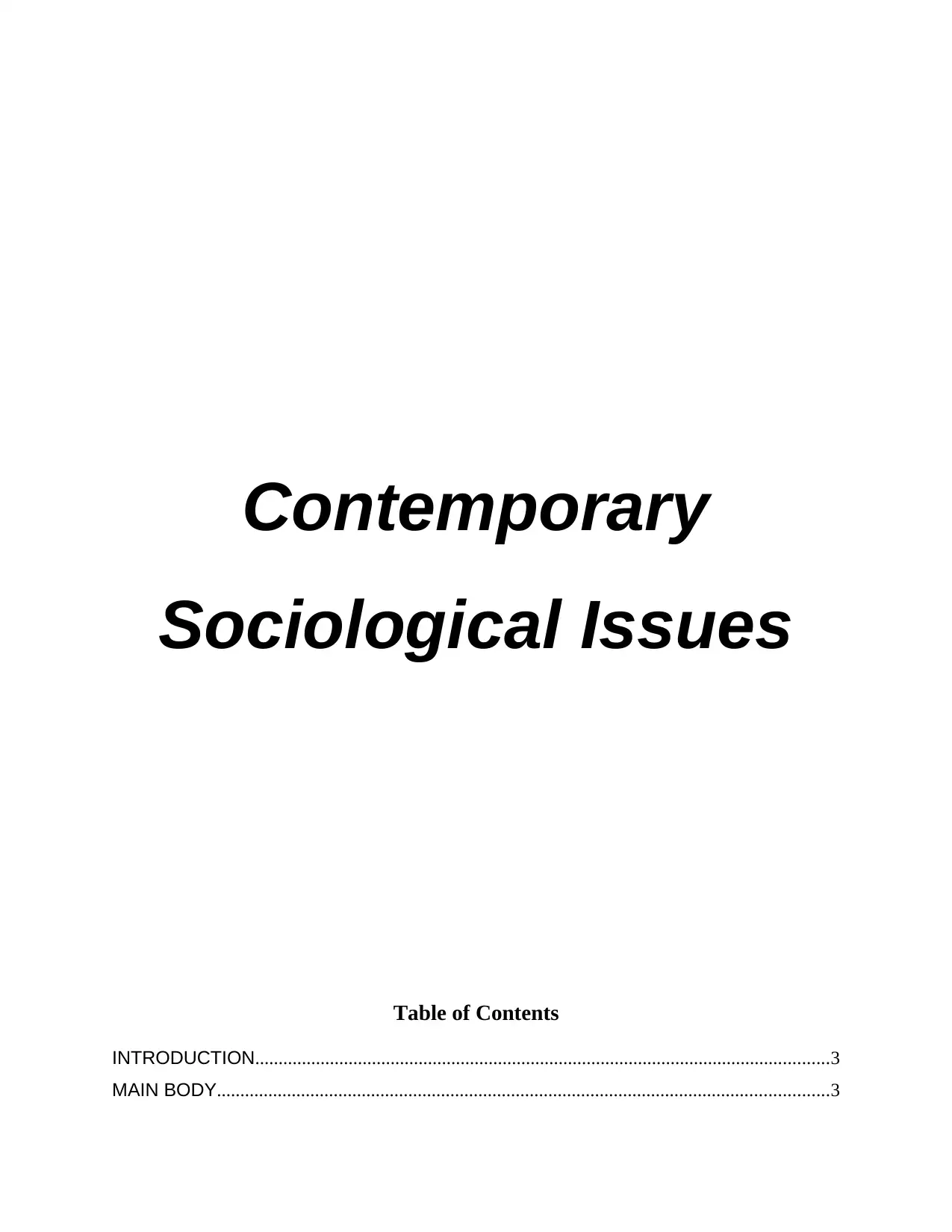
Contemporary
Sociological Issues
Table of Contents
INTRODUCTION...........................................................................................................................3
MAIN BODY...................................................................................................................................3
Sociological Issues
Table of Contents
INTRODUCTION...........................................................................................................................3
MAIN BODY...................................................................................................................................3
Paraphrase This Document
Need a fresh take? Get an instant paraphrase of this document with our AI Paraphraser
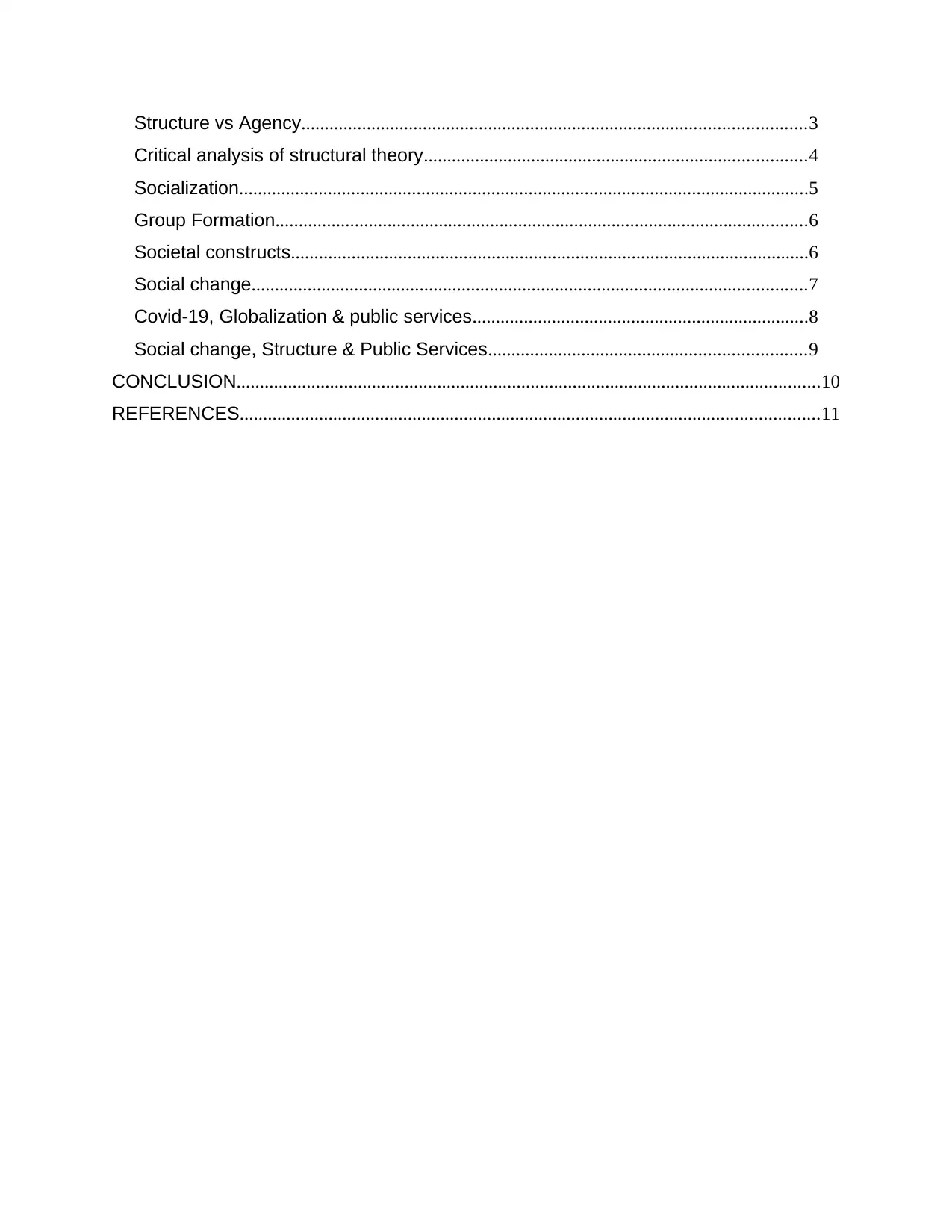
Structure vs Agency............................................................................................................3
Critical analysis of structural theory..................................................................................4
Socialization..........................................................................................................................5
Group Formation..................................................................................................................6
Societal constructs...............................................................................................................6
Social change.......................................................................................................................7
Covid-19, Globalization & public services........................................................................8
Social change, Structure & Public Services....................................................................9
CONCLUSION.............................................................................................................................10
REFERENCES............................................................................................................................11
Critical analysis of structural theory..................................................................................4
Socialization..........................................................................................................................5
Group Formation..................................................................................................................6
Societal constructs...............................................................................................................6
Social change.......................................................................................................................7
Covid-19, Globalization & public services........................................................................8
Social change, Structure & Public Services....................................................................9
CONCLUSION.............................................................................................................................10
REFERENCES............................................................................................................................11
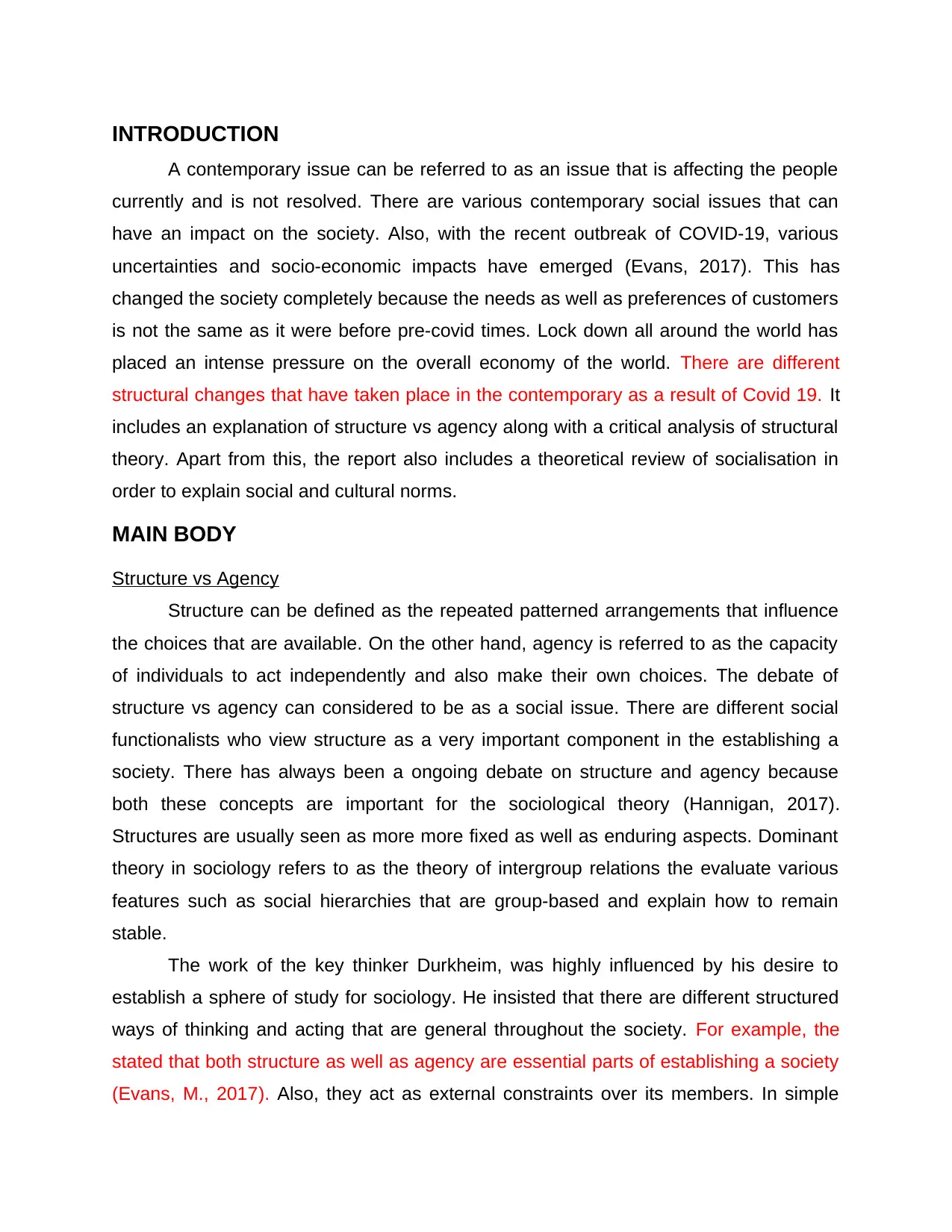
INTRODUCTION
A contemporary issue can be referred to as an issue that is affecting the people
currently and is not resolved. There are various contemporary social issues that can
have an impact on the society. Also, with the recent outbreak of COVID-19, various
uncertainties and socio-economic impacts have emerged (Evans, 2017). This has
changed the society completely because the needs as well as preferences of customers
is not the same as it were before pre-covid times. Lock down all around the world has
placed an intense pressure on the overall economy of the world. There are different
structural changes that have taken place in the contemporary as a result of Covid 19. It
includes an explanation of structure vs agency along with a critical analysis of structural
theory. Apart from this, the report also includes a theoretical review of socialisation in
order to explain social and cultural norms.
MAIN BODY
Structure vs Agency
Structure can be defined as the repeated patterned arrangements that influence
the choices that are available. On the other hand, agency is referred to as the capacity
of individuals to act independently and also make their own choices. The debate of
structure vs agency can considered to be as a social issue. There are different social
functionalists who view structure as a very important component in the establishing a
society. There has always been a ongoing debate on structure and agency because
both these concepts are important for the sociological theory (Hannigan, 2017).
Structures are usually seen as more more fixed as well as enduring aspects. Dominant
theory in sociology refers to as the theory of intergroup relations the evaluate various
features such as social hierarchies that are group-based and explain how to remain
stable.
The work of the key thinker Durkheim, was highly influenced by his desire to
establish a sphere of study for sociology. He insisted that there are different structured
ways of thinking and acting that are general throughout the society. For example, the
stated that both structure as well as agency are essential parts of establishing a society
(Evans, M., 2017). Also, they act as external constraints over its members. In simple
A contemporary issue can be referred to as an issue that is affecting the people
currently and is not resolved. There are various contemporary social issues that can
have an impact on the society. Also, with the recent outbreak of COVID-19, various
uncertainties and socio-economic impacts have emerged (Evans, 2017). This has
changed the society completely because the needs as well as preferences of customers
is not the same as it were before pre-covid times. Lock down all around the world has
placed an intense pressure on the overall economy of the world. There are different
structural changes that have taken place in the contemporary as a result of Covid 19. It
includes an explanation of structure vs agency along with a critical analysis of structural
theory. Apart from this, the report also includes a theoretical review of socialisation in
order to explain social and cultural norms.
MAIN BODY
Structure vs Agency
Structure can be defined as the repeated patterned arrangements that influence
the choices that are available. On the other hand, agency is referred to as the capacity
of individuals to act independently and also make their own choices. The debate of
structure vs agency can considered to be as a social issue. There are different social
functionalists who view structure as a very important component in the establishing a
society. There has always been a ongoing debate on structure and agency because
both these concepts are important for the sociological theory (Hannigan, 2017).
Structures are usually seen as more more fixed as well as enduring aspects. Dominant
theory in sociology refers to as the theory of intergroup relations the evaluate various
features such as social hierarchies that are group-based and explain how to remain
stable.
The work of the key thinker Durkheim, was highly influenced by his desire to
establish a sphere of study for sociology. He insisted that there are different structured
ways of thinking and acting that are general throughout the society. For example, the
stated that both structure as well as agency are essential parts of establishing a society
(Evans, M., 2017). Also, they act as external constraints over its members. In simple
⊘ This is a preview!⊘
Do you want full access?
Subscribe today to unlock all pages.

Trusted by 1+ million students worldwide
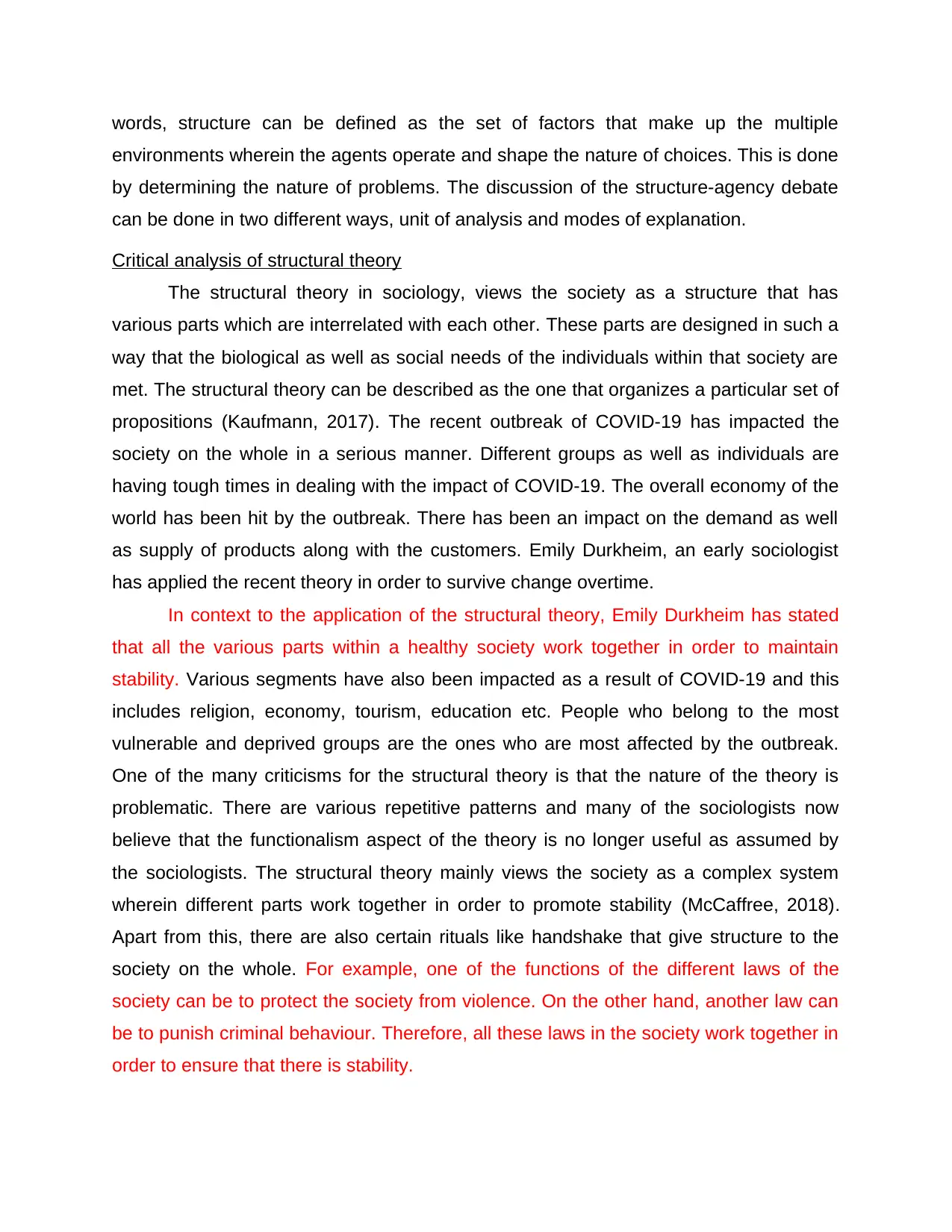
words, structure can be defined as the set of factors that make up the multiple
environments wherein the agents operate and shape the nature of choices. This is done
by determining the nature of problems. The discussion of the structure-agency debate
can be done in two different ways, unit of analysis and modes of explanation.
Critical analysis of structural theory
The structural theory in sociology, views the society as a structure that has
various parts which are interrelated with each other. These parts are designed in such a
way that the biological as well as social needs of the individuals within that society are
met. The structural theory can be described as the one that organizes a particular set of
propositions (Kaufmann, 2017). The recent outbreak of COVID-19 has impacted the
society on the whole in a serious manner. Different groups as well as individuals are
having tough times in dealing with the impact of COVID-19. The overall economy of the
world has been hit by the outbreak. There has been an impact on the demand as well
as supply of products along with the customers. Emily Durkheim, an early sociologist
has applied the recent theory in order to survive change overtime.
In context to the application of the structural theory, Emily Durkheim has stated
that all the various parts within a healthy society work together in order to maintain
stability. Various segments have also been impacted as a result of COVID-19 and this
includes religion, economy, tourism, education etc. People who belong to the most
vulnerable and deprived groups are the ones who are most affected by the outbreak.
One of the many criticisms for the structural theory is that the nature of the theory is
problematic. There are various repetitive patterns and many of the sociologists now
believe that the functionalism aspect of the theory is no longer useful as assumed by
the sociologists. The structural theory mainly views the society as a complex system
wherein different parts work together in order to promote stability (McCaffree, 2018).
Apart from this, there are also certain rituals like handshake that give structure to the
society on the whole. For example, one of the functions of the different laws of the
society can be to protect the society from violence. On the other hand, another law can
be to punish criminal behaviour. Therefore, all these laws in the society work together in
order to ensure that there is stability.
environments wherein the agents operate and shape the nature of choices. This is done
by determining the nature of problems. The discussion of the structure-agency debate
can be done in two different ways, unit of analysis and modes of explanation.
Critical analysis of structural theory
The structural theory in sociology, views the society as a structure that has
various parts which are interrelated with each other. These parts are designed in such a
way that the biological as well as social needs of the individuals within that society are
met. The structural theory can be described as the one that organizes a particular set of
propositions (Kaufmann, 2017). The recent outbreak of COVID-19 has impacted the
society on the whole in a serious manner. Different groups as well as individuals are
having tough times in dealing with the impact of COVID-19. The overall economy of the
world has been hit by the outbreak. There has been an impact on the demand as well
as supply of products along with the customers. Emily Durkheim, an early sociologist
has applied the recent theory in order to survive change overtime.
In context to the application of the structural theory, Emily Durkheim has stated
that all the various parts within a healthy society work together in order to maintain
stability. Various segments have also been impacted as a result of COVID-19 and this
includes religion, economy, tourism, education etc. People who belong to the most
vulnerable and deprived groups are the ones who are most affected by the outbreak.
One of the many criticisms for the structural theory is that the nature of the theory is
problematic. There are various repetitive patterns and many of the sociologists now
believe that the functionalism aspect of the theory is no longer useful as assumed by
the sociologists. The structural theory mainly views the society as a complex system
wherein different parts work together in order to promote stability (McCaffree, 2018).
Apart from this, there are also certain rituals like handshake that give structure to the
society on the whole. For example, one of the functions of the different laws of the
society can be to protect the society from violence. On the other hand, another law can
be to punish criminal behaviour. Therefore, all these laws in the society work together in
order to ensure that there is stability.
Paraphrase This Document
Need a fresh take? Get an instant paraphrase of this document with our AI Paraphraser
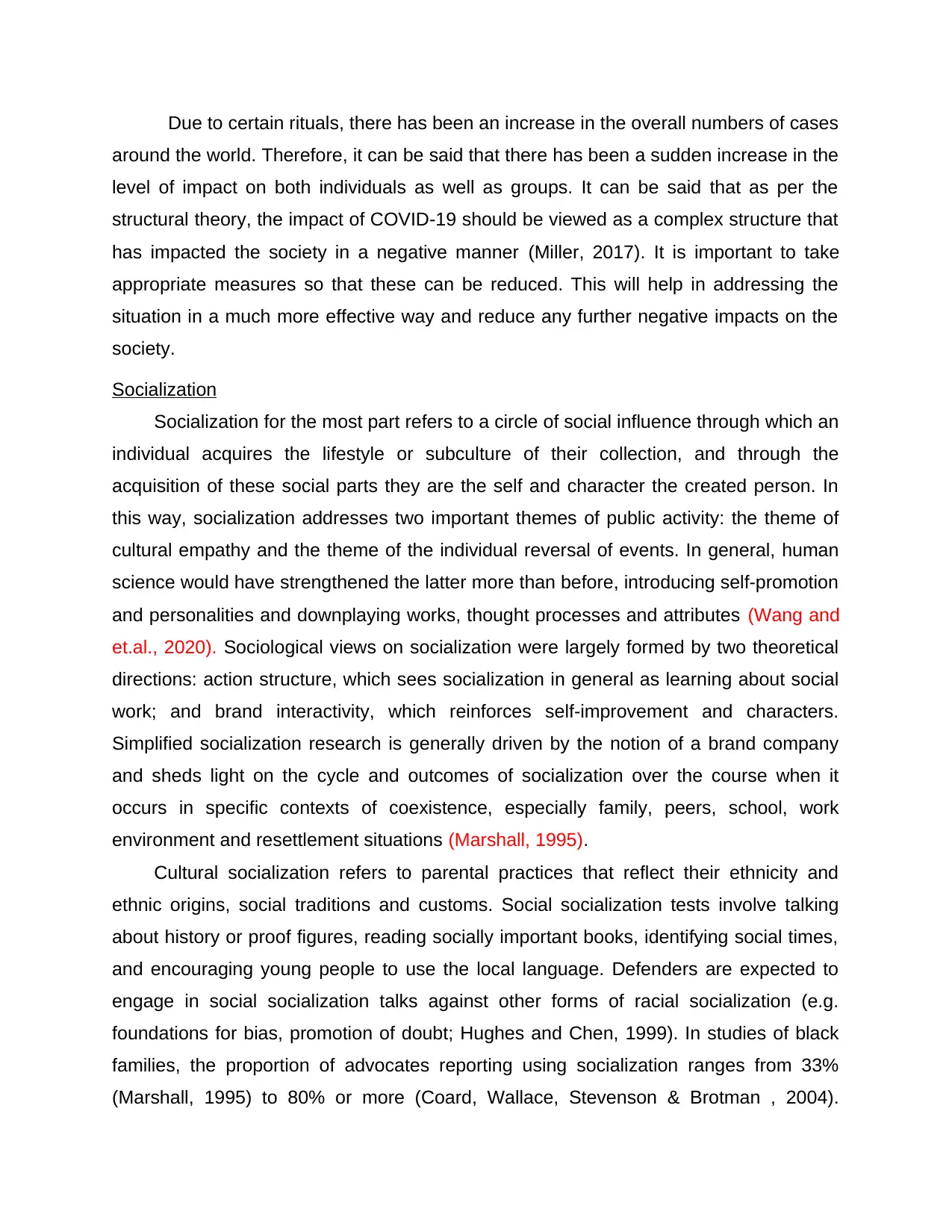
Due to certain rituals, there has been an increase in the overall numbers of cases
around the world. Therefore, it can be said that there has been a sudden increase in the
level of impact on both individuals as well as groups. It can be said that as per the
structural theory, the impact of COVID-19 should be viewed as a complex structure that
has impacted the society in a negative manner (Miller, 2017). It is important to take
appropriate measures so that these can be reduced. This will help in addressing the
situation in a much more effective way and reduce any further negative impacts on the
society.
Socialization
Socialization for the most part refers to a circle of social influence through which an
individual acquires the lifestyle or subculture of their collection, and through the
acquisition of these social parts they are the self and character the created person. In
this way, socialization addresses two important themes of public activity: the theme of
cultural empathy and the theme of the individual reversal of events. In general, human
science would have strengthened the latter more than before, introducing self-promotion
and personalities and downplaying works, thought processes and attributes (Wang and
et.al., 2020). Sociological views on socialization were largely formed by two theoretical
directions: action structure, which sees socialization in general as learning about social
work; and brand interactivity, which reinforces self-improvement and characters.
Simplified socialization research is generally driven by the notion of a brand company
and sheds light on the cycle and outcomes of socialization over the course when it
occurs in specific contexts of coexistence, especially family, peers, school, work
environment and resettlement situations (Marshall, 1995).
Cultural socialization refers to parental practices that reflect their ethnicity and
ethnic origins, social traditions and customs. Social socialization tests involve talking
about history or proof figures, reading socially important books, identifying social times,
and encouraging young people to use the local language. Defenders are expected to
engage in social socialization talks against other forms of racial socialization (e.g.
foundations for bias, promotion of doubt; Hughes and Chen, 1999). In studies of black
families, the proportion of advocates reporting using socialization ranges from 33%
(Marshall, 1995) to 80% or more (Coard, Wallace, Stevenson & Brotman , 2004).
around the world. Therefore, it can be said that there has been a sudden increase in the
level of impact on both individuals as well as groups. It can be said that as per the
structural theory, the impact of COVID-19 should be viewed as a complex structure that
has impacted the society in a negative manner (Miller, 2017). It is important to take
appropriate measures so that these can be reduced. This will help in addressing the
situation in a much more effective way and reduce any further negative impacts on the
society.
Socialization
Socialization for the most part refers to a circle of social influence through which an
individual acquires the lifestyle or subculture of their collection, and through the
acquisition of these social parts they are the self and character the created person. In
this way, socialization addresses two important themes of public activity: the theme of
cultural empathy and the theme of the individual reversal of events. In general, human
science would have strengthened the latter more than before, introducing self-promotion
and personalities and downplaying works, thought processes and attributes (Wang and
et.al., 2020). Sociological views on socialization were largely formed by two theoretical
directions: action structure, which sees socialization in general as learning about social
work; and brand interactivity, which reinforces self-improvement and characters.
Simplified socialization research is generally driven by the notion of a brand company
and sheds light on the cycle and outcomes of socialization over the course when it
occurs in specific contexts of coexistence, especially family, peers, school, work
environment and resettlement situations (Marshall, 1995).
Cultural socialization refers to parental practices that reflect their ethnicity and
ethnic origins, social traditions and customs. Social socialization tests involve talking
about history or proof figures, reading socially important books, identifying social times,
and encouraging young people to use the local language. Defenders are expected to
engage in social socialization talks against other forms of racial socialization (e.g.
foundations for bias, promotion of doubt; Hughes and Chen, 1999). In studies of black
families, the proportion of advocates reporting using socialization ranges from 33%
(Marshall, 1995) to 80% or more (Coard, Wallace, Stevenson & Brotman , 2004).
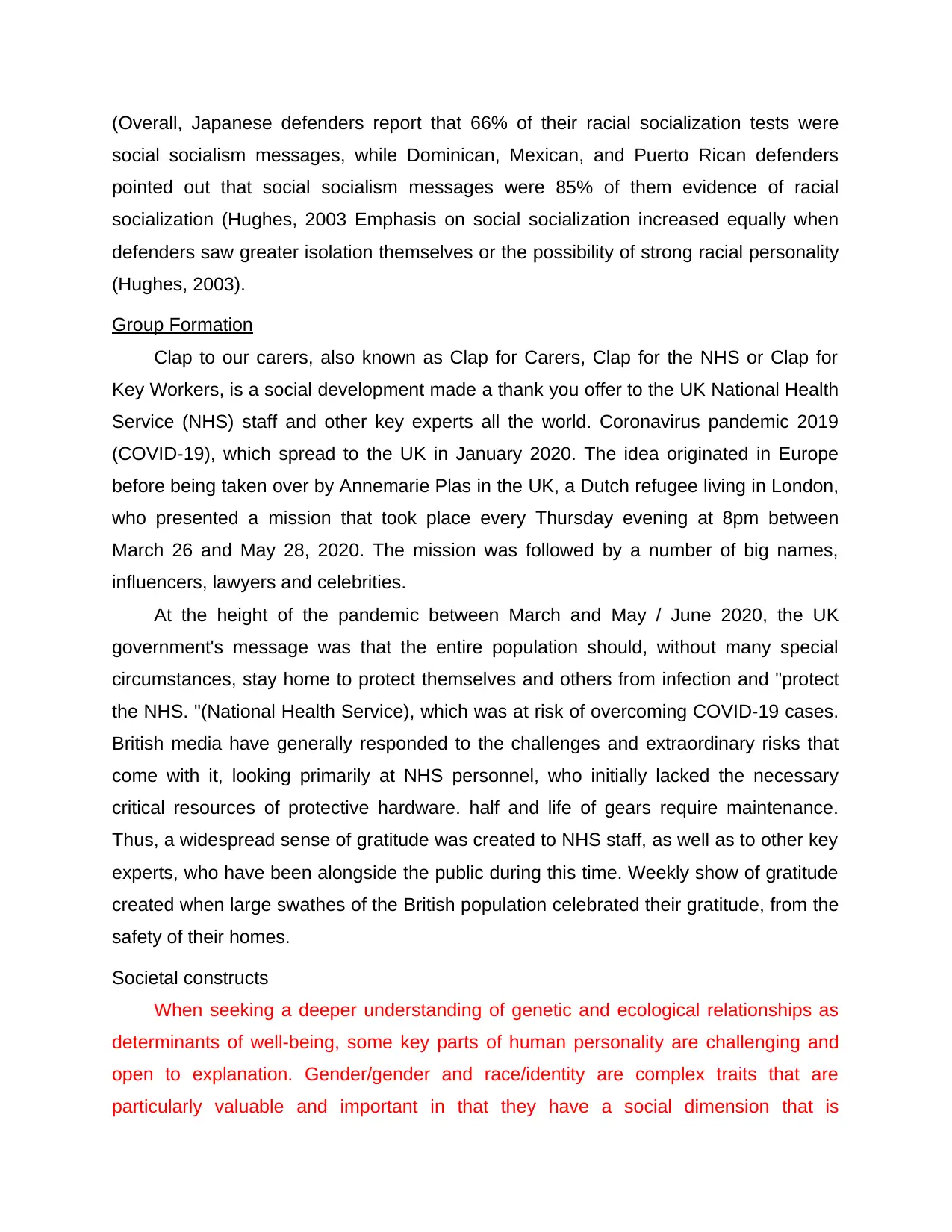
(Overall, Japanese defenders report that 66% of their racial socialization tests were
social socialism messages, while Dominican, Mexican, and Puerto Rican defenders
pointed out that social socialism messages were 85% of them evidence of racial
socialization (Hughes, 2003 Emphasis on social socialization increased equally when
defenders saw greater isolation themselves or the possibility of strong racial personality
(Hughes, 2003).
Group Formation
Clap to our carers, also known as Clap for Carers, Clap for the NHS or Clap for
Key Workers, is a social development made a thank you offer to the UK National Health
Service (NHS) staff and other key experts all the world. Coronavirus pandemic 2019
(COVID-19), which spread to the UK in January 2020. The idea originated in Europe
before being taken over by Annemarie Plas in the UK, a Dutch refugee living in London,
who presented a mission that took place every Thursday evening at 8pm between
March 26 and May 28, 2020. The mission was followed by a number of big names,
influencers, lawyers and celebrities.
At the height of the pandemic between March and May / June 2020, the UK
government's message was that the entire population should, without many special
circumstances, stay home to protect themselves and others from infection and "protect
the NHS. "(National Health Service), which was at risk of overcoming COVID-19 cases.
British media have generally responded to the challenges and extraordinary risks that
come with it, looking primarily at NHS personnel, who initially lacked the necessary
critical resources of protective hardware. half and life of gears require maintenance.
Thus, a widespread sense of gratitude was created to NHS staff, as well as to other key
experts, who have been alongside the public during this time. Weekly show of gratitude
created when large swathes of the British population celebrated their gratitude, from the
safety of their homes.
Societal constructs
When seeking a deeper understanding of genetic and ecological relationships as
determinants of well-being, some key parts of human personality are challenging and
open to explanation. Gender/gender and race/identity are complex traits that are
particularly valuable and important in that they have a social dimension that is
social socialism messages, while Dominican, Mexican, and Puerto Rican defenders
pointed out that social socialism messages were 85% of them evidence of racial
socialization (Hughes, 2003 Emphasis on social socialization increased equally when
defenders saw greater isolation themselves or the possibility of strong racial personality
(Hughes, 2003).
Group Formation
Clap to our carers, also known as Clap for Carers, Clap for the NHS or Clap for
Key Workers, is a social development made a thank you offer to the UK National Health
Service (NHS) staff and other key experts all the world. Coronavirus pandemic 2019
(COVID-19), which spread to the UK in January 2020. The idea originated in Europe
before being taken over by Annemarie Plas in the UK, a Dutch refugee living in London,
who presented a mission that took place every Thursday evening at 8pm between
March 26 and May 28, 2020. The mission was followed by a number of big names,
influencers, lawyers and celebrities.
At the height of the pandemic between March and May / June 2020, the UK
government's message was that the entire population should, without many special
circumstances, stay home to protect themselves and others from infection and "protect
the NHS. "(National Health Service), which was at risk of overcoming COVID-19 cases.
British media have generally responded to the challenges and extraordinary risks that
come with it, looking primarily at NHS personnel, who initially lacked the necessary
critical resources of protective hardware. half and life of gears require maintenance.
Thus, a widespread sense of gratitude was created to NHS staff, as well as to other key
experts, who have been alongside the public during this time. Weekly show of gratitude
created when large swathes of the British population celebrated their gratitude, from the
safety of their homes.
Societal constructs
When seeking a deeper understanding of genetic and ecological relationships as
determinants of well-being, some key parts of human personality are challenging and
open to explanation. Gender/gender and race/identity are complex traits that are
particularly valuable and important in that they have a social dimension that is
⊘ This is a preview!⊘
Do you want full access?
Subscribe today to unlock all pages.

Trusted by 1+ million students worldwide
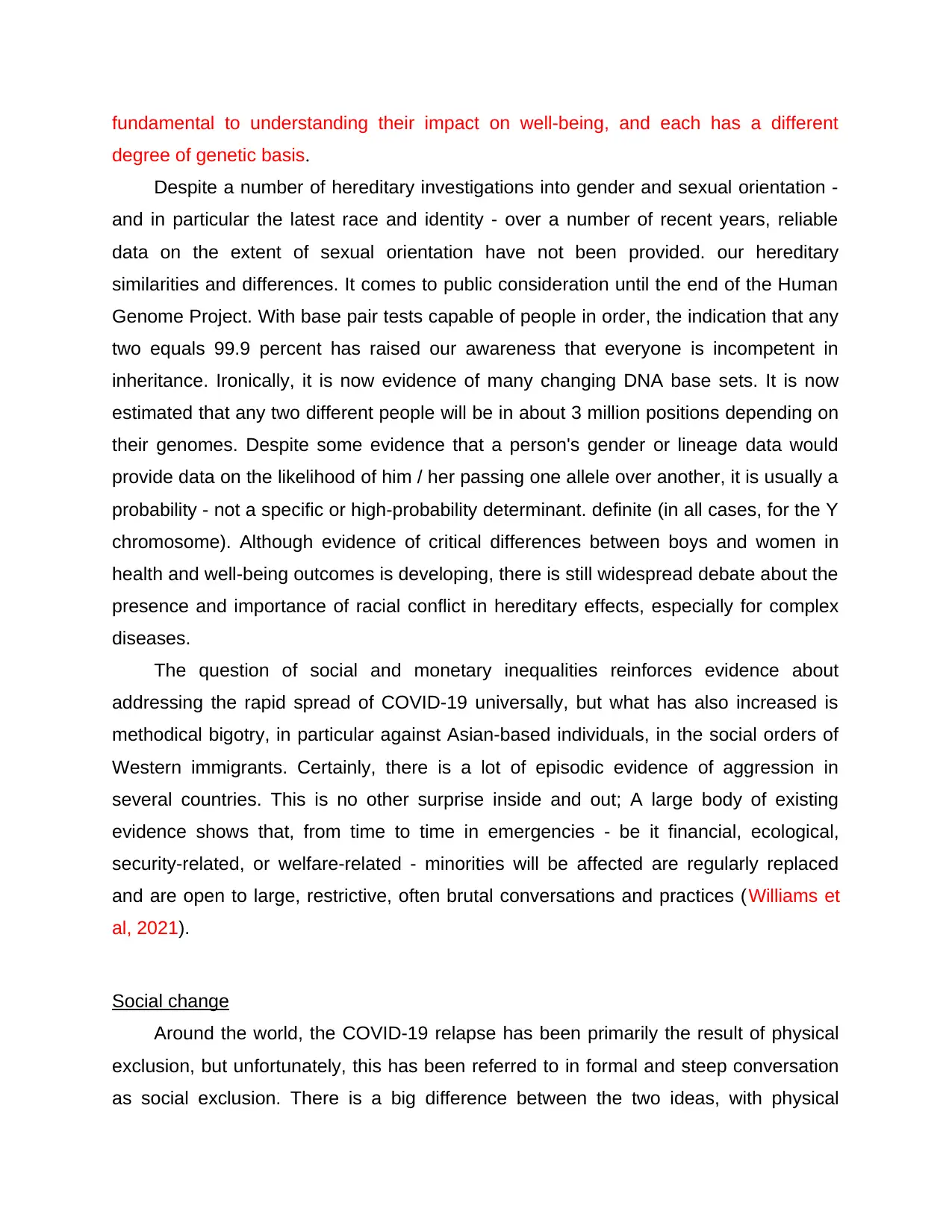
fundamental to understanding their impact on well-being, and each has a different
degree of genetic basis.
Despite a number of hereditary investigations into gender and sexual orientation -
and in particular the latest race and identity - over a number of recent years, reliable
data on the extent of sexual orientation have not been provided. our hereditary
similarities and differences. It comes to public consideration until the end of the Human
Genome Project. With base pair tests capable of people in order, the indication that any
two equals 99.9 percent has raised our awareness that everyone is incompetent in
inheritance. Ironically, it is now evidence of many changing DNA base sets. It is now
estimated that any two different people will be in about 3 million positions depending on
their genomes. Despite some evidence that a person's gender or lineage data would
provide data on the likelihood of him / her passing one allele over another, it is usually a
probability - not a specific or high-probability determinant. definite (in all cases, for the Y
chromosome). Although evidence of critical differences between boys and women in
health and well-being outcomes is developing, there is still widespread debate about the
presence and importance of racial conflict in hereditary effects, especially for complex
diseases.
The question of social and monetary inequalities reinforces evidence about
addressing the rapid spread of COVID-19 universally, but what has also increased is
methodical bigotry, in particular against Asian-based individuals, in the social orders of
Western immigrants. Certainly, there is a lot of episodic evidence of aggression in
several countries. This is no other surprise inside and out; A large body of existing
evidence shows that, from time to time in emergencies - be it financial, ecological,
security-related, or welfare-related - minorities will be affected are regularly replaced
and are open to large, restrictive, often brutal conversations and practices (Williams et
al, 2021).
Social change
Around the world, the COVID-19 relapse has been primarily the result of physical
exclusion, but unfortunately, this has been referred to in formal and steep conversation
as social exclusion. There is a big difference between the two ideas, with physical
degree of genetic basis.
Despite a number of hereditary investigations into gender and sexual orientation -
and in particular the latest race and identity - over a number of recent years, reliable
data on the extent of sexual orientation have not been provided. our hereditary
similarities and differences. It comes to public consideration until the end of the Human
Genome Project. With base pair tests capable of people in order, the indication that any
two equals 99.9 percent has raised our awareness that everyone is incompetent in
inheritance. Ironically, it is now evidence of many changing DNA base sets. It is now
estimated that any two different people will be in about 3 million positions depending on
their genomes. Despite some evidence that a person's gender or lineage data would
provide data on the likelihood of him / her passing one allele over another, it is usually a
probability - not a specific or high-probability determinant. definite (in all cases, for the Y
chromosome). Although evidence of critical differences between boys and women in
health and well-being outcomes is developing, there is still widespread debate about the
presence and importance of racial conflict in hereditary effects, especially for complex
diseases.
The question of social and monetary inequalities reinforces evidence about
addressing the rapid spread of COVID-19 universally, but what has also increased is
methodical bigotry, in particular against Asian-based individuals, in the social orders of
Western immigrants. Certainly, there is a lot of episodic evidence of aggression in
several countries. This is no other surprise inside and out; A large body of existing
evidence shows that, from time to time in emergencies - be it financial, ecological,
security-related, or welfare-related - minorities will be affected are regularly replaced
and are open to large, restrictive, often brutal conversations and practices (Williams et
al, 2021).
Social change
Around the world, the COVID-19 relapse has been primarily the result of physical
exclusion, but unfortunately, this has been referred to in formal and steep conversation
as social exclusion. There is a big difference between the two ideas, with physical
Paraphrase This Document
Need a fresh take? Get an instant paraphrase of this document with our AI Paraphraser
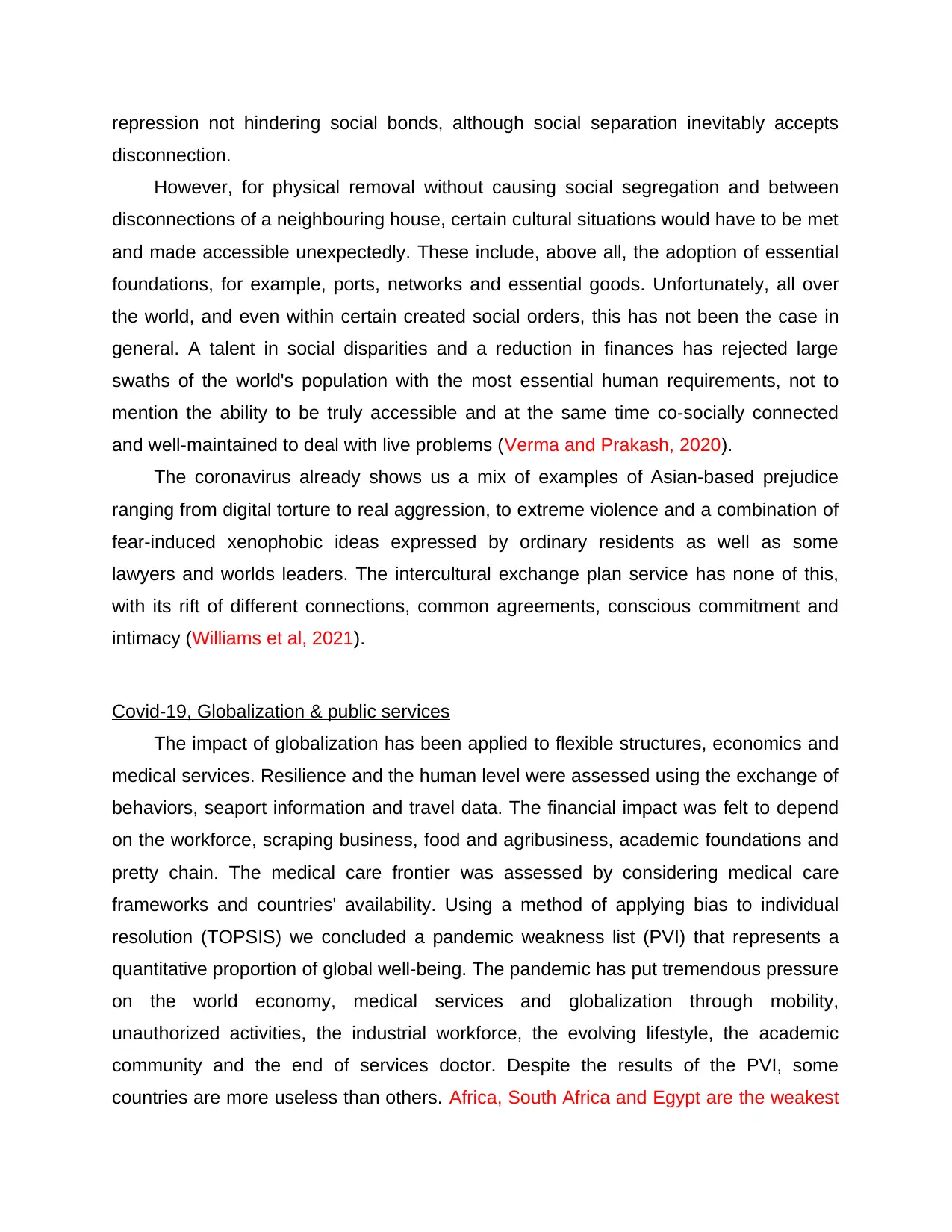
repression not hindering social bonds, although social separation inevitably accepts
disconnection.
However, for physical removal without causing social segregation and between
disconnections of a neighbouring house, certain cultural situations would have to be met
and made accessible unexpectedly. These include, above all, the adoption of essential
foundations, for example, ports, networks and essential goods. Unfortunately, all over
the world, and even within certain created social orders, this has not been the case in
general. A talent in social disparities and a reduction in finances has rejected large
swaths of the world's population with the most essential human requirements, not to
mention the ability to be truly accessible and at the same time co-socially connected
and well-maintained to deal with live problems (Verma and Prakash, 2020).
The coronavirus already shows us a mix of examples of Asian-based prejudice
ranging from digital torture to real aggression, to extreme violence and a combination of
fear-induced xenophobic ideas expressed by ordinary residents as well as some
lawyers and worlds leaders. The intercultural exchange plan service has none of this,
with its rift of different connections, common agreements, conscious commitment and
intimacy (Williams et al, 2021).
Covid-19, Globalization & public services
The impact of globalization has been applied to flexible structures, economics and
medical services. Resilience and the human level were assessed using the exchange of
behaviors, seaport information and travel data. The financial impact was felt to depend
on the workforce, scraping business, food and agribusiness, academic foundations and
pretty chain. The medical care frontier was assessed by considering medical care
frameworks and countries' availability. Using a method of applying bias to individual
resolution (TOPSIS) we concluded a pandemic weakness list (PVI) that represents a
quantitative proportion of global well-being. The pandemic has put tremendous pressure
on the world economy, medical services and globalization through mobility,
unauthorized activities, the industrial workforce, the evolving lifestyle, the academic
community and the end of services doctor. Despite the results of the PVI, some
countries are more useless than others. Africa, South Africa and Egypt are the weakest
disconnection.
However, for physical removal without causing social segregation and between
disconnections of a neighbouring house, certain cultural situations would have to be met
and made accessible unexpectedly. These include, above all, the adoption of essential
foundations, for example, ports, networks and essential goods. Unfortunately, all over
the world, and even within certain created social orders, this has not been the case in
general. A talent in social disparities and a reduction in finances has rejected large
swaths of the world's population with the most essential human requirements, not to
mention the ability to be truly accessible and at the same time co-socially connected
and well-maintained to deal with live problems (Verma and Prakash, 2020).
The coronavirus already shows us a mix of examples of Asian-based prejudice
ranging from digital torture to real aggression, to extreme violence and a combination of
fear-induced xenophobic ideas expressed by ordinary residents as well as some
lawyers and worlds leaders. The intercultural exchange plan service has none of this,
with its rift of different connections, common agreements, conscious commitment and
intimacy (Williams et al, 2021).
Covid-19, Globalization & public services
The impact of globalization has been applied to flexible structures, economics and
medical services. Resilience and the human level were assessed using the exchange of
behaviors, seaport information and travel data. The financial impact was felt to depend
on the workforce, scraping business, food and agribusiness, academic foundations and
pretty chain. The medical care frontier was assessed by considering medical care
frameworks and countries' availability. Using a method of applying bias to individual
resolution (TOPSIS) we concluded a pandemic weakness list (PVI) that represents a
quantitative proportion of global well-being. The pandemic has put tremendous pressure
on the world economy, medical services and globalization through mobility,
unauthorized activities, the industrial workforce, the evolving lifestyle, the academic
community and the end of services doctor. Despite the results of the PVI, some
countries are more useless than others. Africa, South Africa and Egypt are the weakest
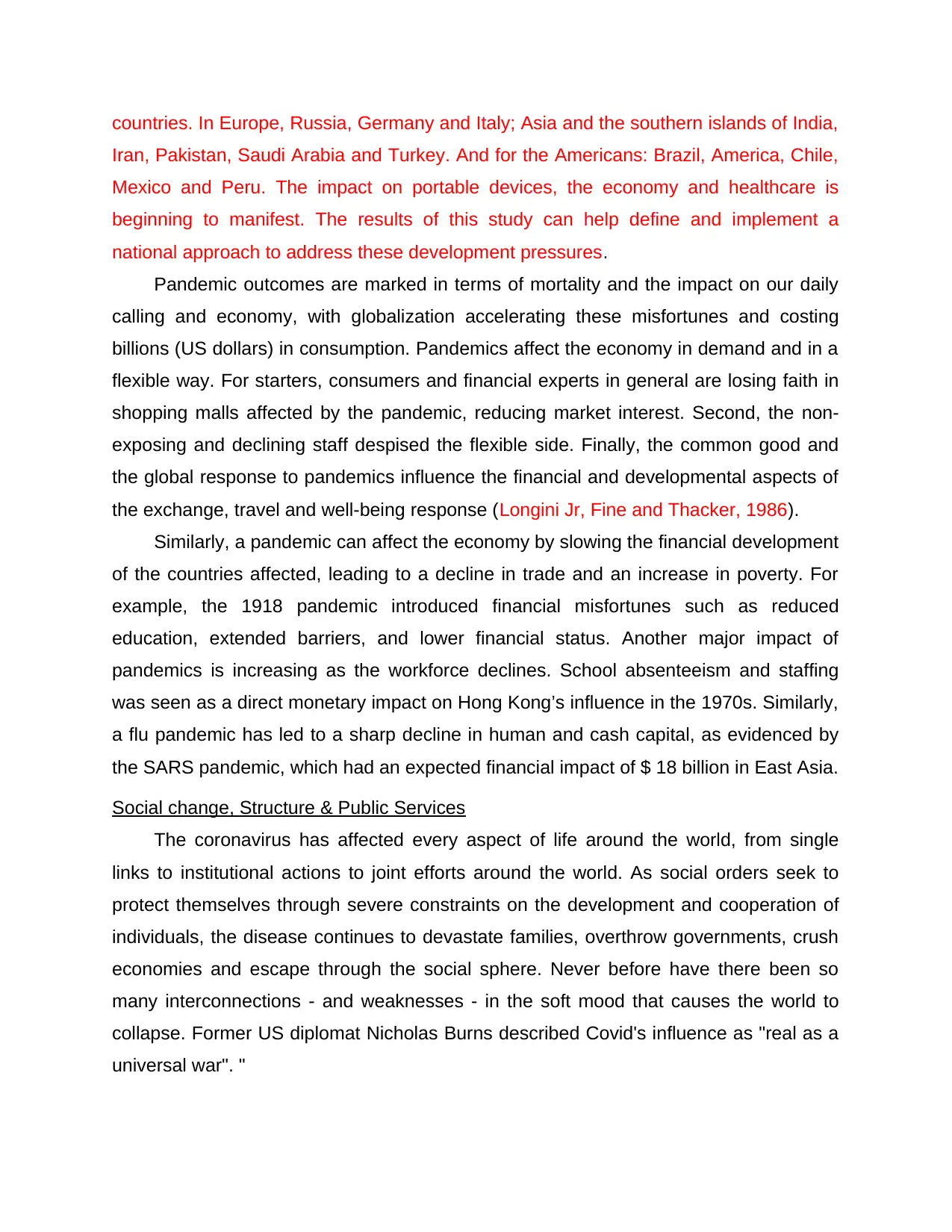
countries. In Europe, Russia, Germany and Italy; Asia and the southern islands of India,
Iran, Pakistan, Saudi Arabia and Turkey. And for the Americans: Brazil, America, Chile,
Mexico and Peru. The impact on portable devices, the economy and healthcare is
beginning to manifest. The results of this study can help define and implement a
national approach to address these development pressures.
Pandemic outcomes are marked in terms of mortality and the impact on our daily
calling and economy, with globalization accelerating these misfortunes and costing
billions (US dollars) in consumption. Pandemics affect the economy in demand and in a
flexible way. For starters, consumers and financial experts in general are losing faith in
shopping malls affected by the pandemic, reducing market interest. Second, the non-
exposing and declining staff despised the flexible side. Finally, the common good and
the global response to pandemics influence the financial and developmental aspects of
the exchange, travel and well-being response (Longini Jr, Fine and Thacker, 1986).
Similarly, a pandemic can affect the economy by slowing the financial development
of the countries affected, leading to a decline in trade and an increase in poverty. For
example, the 1918 pandemic introduced financial misfortunes such as reduced
education, extended barriers, and lower financial status. Another major impact of
pandemics is increasing as the workforce declines. School absenteeism and staffing
was seen as a direct monetary impact on Hong Kong’s influence in the 1970s. Similarly,
a flu pandemic has led to a sharp decline in human and cash capital, as evidenced by
the SARS pandemic, which had an expected financial impact of $ 18 billion in East Asia.
Social change, Structure & Public Services
The coronavirus has affected every aspect of life around the world, from single
links to institutional actions to joint efforts around the world. As social orders seek to
protect themselves through severe constraints on the development and cooperation of
individuals, the disease continues to devastate families, overthrow governments, crush
economies and escape through the social sphere. Never before have there been so
many interconnections - and weaknesses - in the soft mood that causes the world to
collapse. Former US diplomat Nicholas Burns described Covid's influence as "real as a
universal war". "
Iran, Pakistan, Saudi Arabia and Turkey. And for the Americans: Brazil, America, Chile,
Mexico and Peru. The impact on portable devices, the economy and healthcare is
beginning to manifest. The results of this study can help define and implement a
national approach to address these development pressures.
Pandemic outcomes are marked in terms of mortality and the impact on our daily
calling and economy, with globalization accelerating these misfortunes and costing
billions (US dollars) in consumption. Pandemics affect the economy in demand and in a
flexible way. For starters, consumers and financial experts in general are losing faith in
shopping malls affected by the pandemic, reducing market interest. Second, the non-
exposing and declining staff despised the flexible side. Finally, the common good and
the global response to pandemics influence the financial and developmental aspects of
the exchange, travel and well-being response (Longini Jr, Fine and Thacker, 1986).
Similarly, a pandemic can affect the economy by slowing the financial development
of the countries affected, leading to a decline in trade and an increase in poverty. For
example, the 1918 pandemic introduced financial misfortunes such as reduced
education, extended barriers, and lower financial status. Another major impact of
pandemics is increasing as the workforce declines. School absenteeism and staffing
was seen as a direct monetary impact on Hong Kong’s influence in the 1970s. Similarly,
a flu pandemic has led to a sharp decline in human and cash capital, as evidenced by
the SARS pandemic, which had an expected financial impact of $ 18 billion in East Asia.
Social change, Structure & Public Services
The coronavirus has affected every aspect of life around the world, from single
links to institutional actions to joint efforts around the world. As social orders seek to
protect themselves through severe constraints on the development and cooperation of
individuals, the disease continues to devastate families, overthrow governments, crush
economies and escape through the social sphere. Never before have there been so
many interconnections - and weaknesses - in the soft mood that causes the world to
collapse. Former US diplomat Nicholas Burns described Covid's influence as "real as a
universal war". "
⊘ This is a preview!⊘
Do you want full access?
Subscribe today to unlock all pages.

Trusted by 1+ million students worldwide
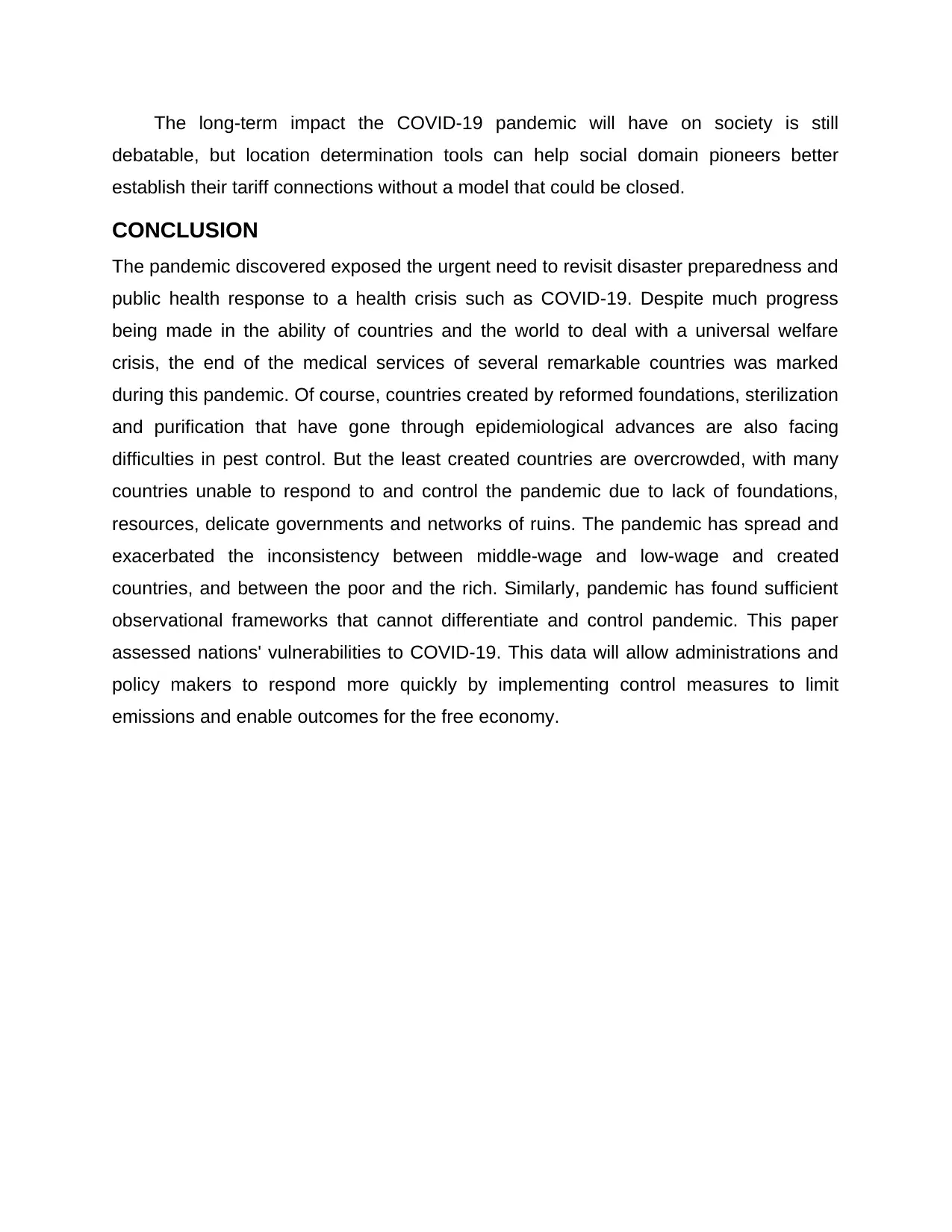
The long-term impact the COVID-19 pandemic will have on society is still
debatable, but location determination tools can help social domain pioneers better
establish their tariff connections without a model that could be closed.
CONCLUSION
The pandemic discovered exposed the urgent need to revisit disaster preparedness and
public health response to a health crisis such as COVID-19. Despite much progress
being made in the ability of countries and the world to deal with a universal welfare
crisis, the end of the medical services of several remarkable countries was marked
during this pandemic. Of course, countries created by reformed foundations, sterilization
and purification that have gone through epidemiological advances are also facing
difficulties in pest control. But the least created countries are overcrowded, with many
countries unable to respond to and control the pandemic due to lack of foundations,
resources, delicate governments and networks of ruins. The pandemic has spread and
exacerbated the inconsistency between middle-wage and low-wage and created
countries, and between the poor and the rich. Similarly, pandemic has found sufficient
observational frameworks that cannot differentiate and control pandemic. This paper
assessed nations' vulnerabilities to COVID-19. This data will allow administrations and
policy makers to respond more quickly by implementing control measures to limit
emissions and enable outcomes for the free economy.
debatable, but location determination tools can help social domain pioneers better
establish their tariff connections without a model that could be closed.
CONCLUSION
The pandemic discovered exposed the urgent need to revisit disaster preparedness and
public health response to a health crisis such as COVID-19. Despite much progress
being made in the ability of countries and the world to deal with a universal welfare
crisis, the end of the medical services of several remarkable countries was marked
during this pandemic. Of course, countries created by reformed foundations, sterilization
and purification that have gone through epidemiological advances are also facing
difficulties in pest control. But the least created countries are overcrowded, with many
countries unable to respond to and control the pandemic due to lack of foundations,
resources, delicate governments and networks of ruins. The pandemic has spread and
exacerbated the inconsistency between middle-wage and low-wage and created
countries, and between the poor and the rich. Similarly, pandemic has found sufficient
observational frameworks that cannot differentiate and control pandemic. This paper
assessed nations' vulnerabilities to COVID-19. This data will allow administrations and
policy makers to respond more quickly by implementing control measures to limit
emissions and enable outcomes for the free economy.
Paraphrase This Document
Need a fresh take? Get an instant paraphrase of this document with our AI Paraphraser
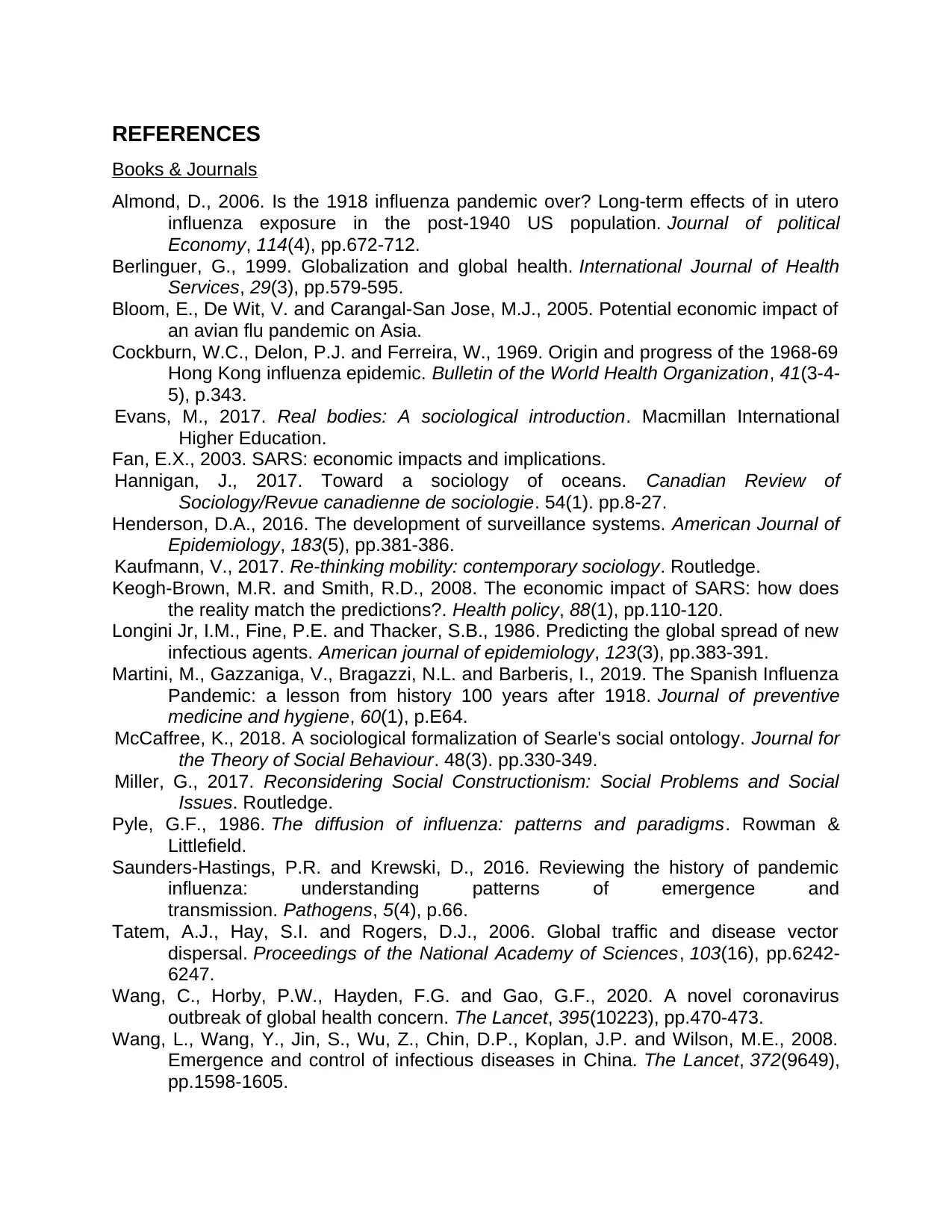
REFERENCES
Books & Journals
Almond, D., 2006. Is the 1918 influenza pandemic over? Long-term effects of in utero
influenza exposure in the post-1940 US population. Journal of political
Economy, 114(4), pp.672-712.
Berlinguer, G., 1999. Globalization and global health. International Journal of Health
Services, 29(3), pp.579-595.
Bloom, E., De Wit, V. and Carangal-San Jose, M.J., 2005. Potential economic impact of
an avian flu pandemic on Asia.
Cockburn, W.C., Delon, P.J. and Ferreira, W., 1969. Origin and progress of the 1968-69
Hong Kong influenza epidemic. Bulletin of the World Health Organization, 41(3-4-
5), p.343.
Evans, M., 2017. Real bodies: A sociological introduction. Macmillan International
Higher Education.
Fan, E.X., 2003. SARS: economic impacts and implications.
Hannigan, J., 2017. Toward a sociology of oceans. Canadian Review of
Sociology/Revue canadienne de sociologie. 54(1). pp.8-27.
Henderson, D.A., 2016. The development of surveillance systems. American Journal of
Epidemiology, 183(5), pp.381-386.
Kaufmann, V., 2017. Re-thinking mobility: contemporary sociology. Routledge.
Keogh-Brown, M.R. and Smith, R.D., 2008. The economic impact of SARS: how does
the reality match the predictions?. Health policy, 88(1), pp.110-120.
Longini Jr, I.M., Fine, P.E. and Thacker, S.B., 1986. Predicting the global spread of new
infectious agents. American journal of epidemiology, 123(3), pp.383-391.
Martini, M., Gazzaniga, V., Bragazzi, N.L. and Barberis, I., 2019. The Spanish Influenza
Pandemic: a lesson from history 100 years after 1918. Journal of preventive
medicine and hygiene, 60(1), p.E64.
McCaffree, K., 2018. A sociological formalization of Searle's social ontology. Journal for
the Theory of Social Behaviour. 48(3). pp.330-349.
Miller, G., 2017. Reconsidering Social Constructionism: Social Problems and Social
Issues. Routledge.
Pyle, G.F., 1986. The diffusion of influenza: patterns and paradigms. Rowman &
Littlefield.
Saunders-Hastings, P.R. and Krewski, D., 2016. Reviewing the history of pandemic
influenza: understanding patterns of emergence and
transmission. Pathogens, 5(4), p.66.
Tatem, A.J., Hay, S.I. and Rogers, D.J., 2006. Global traffic and disease vector
dispersal. Proceedings of the National Academy of Sciences, 103(16), pp.6242-
6247.
Wang, C., Horby, P.W., Hayden, F.G. and Gao, G.F., 2020. A novel coronavirus
outbreak of global health concern. The Lancet, 395(10223), pp.470-473.
Wang, L., Wang, Y., Jin, S., Wu, Z., Chin, D.P., Koplan, J.P. and Wilson, M.E., 2008.
Emergence and control of infectious diseases in China. The Lancet, 372(9649),
pp.1598-1605.
Books & Journals
Almond, D., 2006. Is the 1918 influenza pandemic over? Long-term effects of in utero
influenza exposure in the post-1940 US population. Journal of political
Economy, 114(4), pp.672-712.
Berlinguer, G., 1999. Globalization and global health. International Journal of Health
Services, 29(3), pp.579-595.
Bloom, E., De Wit, V. and Carangal-San Jose, M.J., 2005. Potential economic impact of
an avian flu pandemic on Asia.
Cockburn, W.C., Delon, P.J. and Ferreira, W., 1969. Origin and progress of the 1968-69
Hong Kong influenza epidemic. Bulletin of the World Health Organization, 41(3-4-
5), p.343.
Evans, M., 2017. Real bodies: A sociological introduction. Macmillan International
Higher Education.
Fan, E.X., 2003. SARS: economic impacts and implications.
Hannigan, J., 2017. Toward a sociology of oceans. Canadian Review of
Sociology/Revue canadienne de sociologie. 54(1). pp.8-27.
Henderson, D.A., 2016. The development of surveillance systems. American Journal of
Epidemiology, 183(5), pp.381-386.
Kaufmann, V., 2017. Re-thinking mobility: contemporary sociology. Routledge.
Keogh-Brown, M.R. and Smith, R.D., 2008. The economic impact of SARS: how does
the reality match the predictions?. Health policy, 88(1), pp.110-120.
Longini Jr, I.M., Fine, P.E. and Thacker, S.B., 1986. Predicting the global spread of new
infectious agents. American journal of epidemiology, 123(3), pp.383-391.
Martini, M., Gazzaniga, V., Bragazzi, N.L. and Barberis, I., 2019. The Spanish Influenza
Pandemic: a lesson from history 100 years after 1918. Journal of preventive
medicine and hygiene, 60(1), p.E64.
McCaffree, K., 2018. A sociological formalization of Searle's social ontology. Journal for
the Theory of Social Behaviour. 48(3). pp.330-349.
Miller, G., 2017. Reconsidering Social Constructionism: Social Problems and Social
Issues. Routledge.
Pyle, G.F., 1986. The diffusion of influenza: patterns and paradigms. Rowman &
Littlefield.
Saunders-Hastings, P.R. and Krewski, D., 2016. Reviewing the history of pandemic
influenza: understanding patterns of emergence and
transmission. Pathogens, 5(4), p.66.
Tatem, A.J., Hay, S.I. and Rogers, D.J., 2006. Global traffic and disease vector
dispersal. Proceedings of the National Academy of Sciences, 103(16), pp.6242-
6247.
Wang, C., Horby, P.W., Hayden, F.G. and Gao, G.F., 2020. A novel coronavirus
outbreak of global health concern. The Lancet, 395(10223), pp.470-473.
Wang, L., Wang, Y., Jin, S., Wu, Z., Chin, D.P., Koplan, J.P. and Wilson, M.E., 2008.
Emergence and control of infectious diseases in China. The Lancet, 372(9649),
pp.1598-1605.
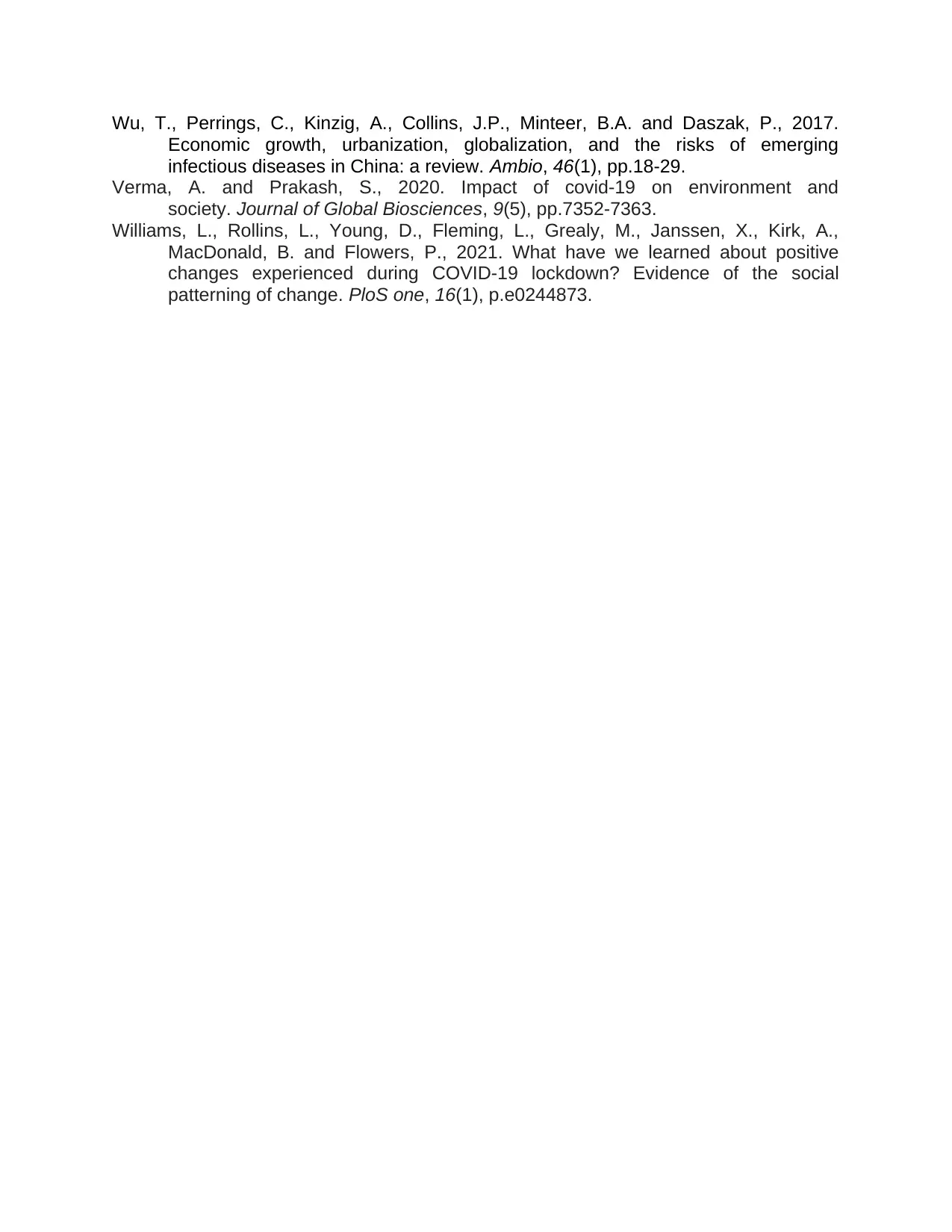
Wu, T., Perrings, C., Kinzig, A., Collins, J.P., Minteer, B.A. and Daszak, P., 2017.
Economic growth, urbanization, globalization, and the risks of emerging
infectious diseases in China: a review. Ambio, 46(1), pp.18-29.
Verma, A. and Prakash, S., 2020. Impact of covid-19 on environment and
society. Journal of Global Biosciences, 9(5), pp.7352-7363.
Williams, L., Rollins, L., Young, D., Fleming, L., Grealy, M., Janssen, X., Kirk, A.,
MacDonald, B. and Flowers, P., 2021. What have we learned about positive
changes experienced during COVID-19 lockdown? Evidence of the social
patterning of change. PloS one, 16(1), p.e0244873.
Economic growth, urbanization, globalization, and the risks of emerging
infectious diseases in China: a review. Ambio, 46(1), pp.18-29.
Verma, A. and Prakash, S., 2020. Impact of covid-19 on environment and
society. Journal of Global Biosciences, 9(5), pp.7352-7363.
Williams, L., Rollins, L., Young, D., Fleming, L., Grealy, M., Janssen, X., Kirk, A.,
MacDonald, B. and Flowers, P., 2021. What have we learned about positive
changes experienced during COVID-19 lockdown? Evidence of the social
patterning of change. PloS one, 16(1), p.e0244873.
⊘ This is a preview!⊘
Do you want full access?
Subscribe today to unlock all pages.

Trusted by 1+ million students worldwide
1 out of 12
Related Documents
Your All-in-One AI-Powered Toolkit for Academic Success.
+13062052269
info@desklib.com
Available 24*7 on WhatsApp / Email
![[object Object]](/_next/static/media/star-bottom.7253800d.svg)
Unlock your academic potential
Copyright © 2020–2025 A2Z Services. All Rights Reserved. Developed and managed by ZUCOL.





